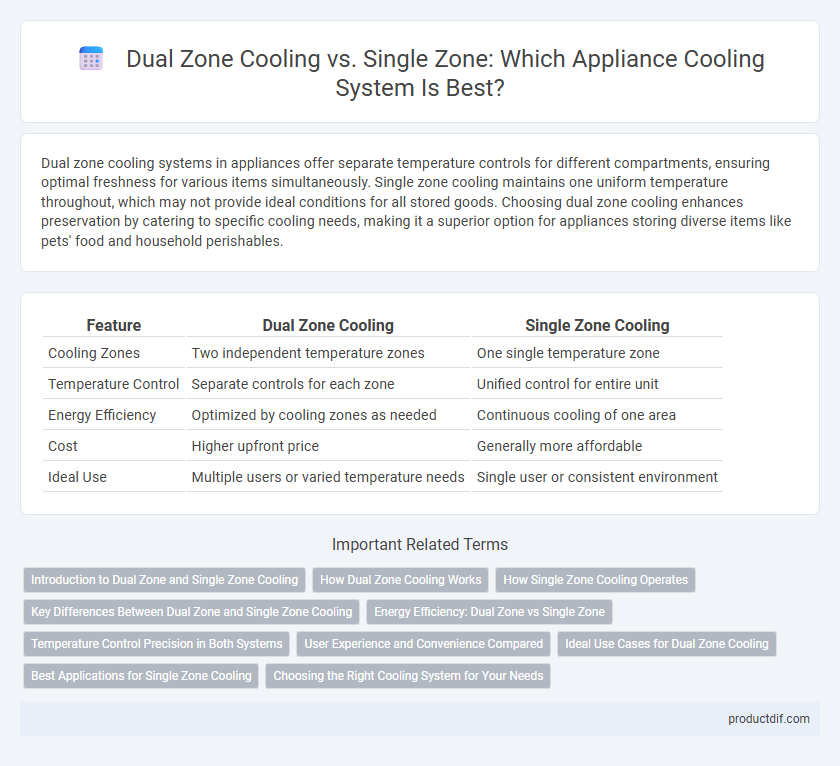Dual zone cooling systems in appliances offer separate temperature controls for different compartments, ensuring optimal freshness for various items simultaneously. Single zone cooling maintains one uniform temperature throughout, which may not provide ideal conditions for all stored goods. Choosing dual zone cooling enhances preservation by catering to specific cooling needs, making it a superior option for appliances storing diverse items like pets' food and household perishables.
Table of Comparison
| Feature | Dual Zone Cooling | Single Zone Cooling |
|---|---|---|
| Cooling Zones | Two independent temperature zones | One single temperature zone |
| Temperature Control | Separate controls for each zone | Unified control for entire unit |
| Energy Efficiency | Optimized by cooling zones as needed | Continuous cooling of one area |
| Cost | Higher upfront price | Generally more affordable |
| Ideal Use | Multiple users or varied temperature needs | Single user or consistent environment |
Introduction to Dual Zone and Single Zone Cooling
Dual zone cooling systems offer independent temperature control for two separate compartments, enhancing food preservation by maintaining optimal conditions for different types of items simultaneously. Single zone cooling units maintain a uniform temperature throughout the compartment, suitable for general storage needs but less effective for items requiring distinct climate settings. Understanding the differences helps consumers choose appliances that best match their cooling requirements and lifestyle preferences.
How Dual Zone Cooling Works
Dual zone cooling appliances operate by using two separate compartments with independent temperature controls, allowing different cooling settings simultaneously for food and beverages. Each zone has individual sensors and thermostats that monitor and maintain precise temperatures suited for specific contents, preventing flavor crossover and optimizing preservation. This targeted cooling technology enhances energy efficiency and extends the freshness of stored items compared to single zone cooling systems.
How Single Zone Cooling Operates
Single Zone Cooling operates by regulating the temperature in one uniform area, using a single thermostat to maintain a consistent climate throughout the designated space. It efficiently manages cooling by cycling the compressor and fan based on a single temperature setting, which simplifies control but limits flexibility in handling temperature variations. This system is ideal for small to medium-sized rooms where uniform cooling is sufficient and zoning is not necessary.
Key Differences Between Dual Zone and Single Zone Cooling
Dual zone cooling appliances feature separate temperature controls for each compartment, allowing precise customization that optimizes energy efficiency and preserves different types of food and beverages. Single zone cooling units maintain a uniform temperature throughout, which may limit flexibility but often simplifies design and reduces cost. The key differences lie in advanced temperature management capabilities, energy consumption patterns, and the intended usage tailored to user preferences for storing diverse items.
Energy Efficiency: Dual Zone vs Single Zone
Dual zone cooling systems optimize energy efficiency by allowing independent temperature control in separate compartments, reducing power consumption compared to single zone units that cool the entire space uniformly. Energy savings of up to 20-30% are reported in households utilizing dual zone appliances due to targeted cooling. Single zone systems may waste energy by overcooling or undercooling areas, while dual zone technology enhances efficiency through precise climate management.
Temperature Control Precision in Both Systems
Dual zone cooling systems offer enhanced temperature control precision by allowing independent adjustment of two separate compartments, ensuring optimal conditions for various food types. Single zone cooling maintains a uniform temperature throughout the appliance, which may compromise the specific needs of different items stored together. This targeted temperature management in dual zone systems results in better preservation of freshness and extended shelf life for diverse food products.
User Experience and Convenience Compared
Dual zone cooling systems offer personalized temperature settings for different compartments, enhancing user comfort and convenience by allowing simultaneous cooling preferences. Single zone cooling appliances maintain a uniform temperature throughout, which may limit flexibility but simplify operation and maintenance. Users benefit from dual zone technology through improved food preservation and tailored climate control, ideal for households with diverse cooling needs.
Ideal Use Cases for Dual Zone Cooling
Dual Zone Cooling units are ideal for households or commercial spaces requiring separate temperature control for different areas, such as combined kitchen and living rooms or retail environments with distinct zones. These appliances optimize energy efficiency by allowing customized cooling settings for each compartment, preserving food freshness and preventing flavor transfer in dual-zone refrigerators. Optimal use cases also include wine storage alongside perishable foods, where precise temperature regulation is critical for maintaining quality.
Best Applications for Single Zone Cooling
Single zone cooling is best suited for small to medium-sized spaces such as single rooms, apartments, or offices where uniform temperature control is sufficient. This system offers energy efficiency by cooling one designated area without the complexity or cost of managing multiple zones. Ideal applications include bedrooms, studio apartments, or individual workspaces where consistent cooling is needed without the necessity of separate temperature settings.
Choosing the Right Cooling System for Your Needs
Dual zone cooling systems offer precise temperature control in separate compartments, ideal for households with varied cooling preferences or different types of food storage. Single zone cooling units are typically more energy-efficient and cost-effective, suitable for uniform cooling needs or smaller spaces. Evaluate factors such as usage patterns, budget, and the need for temperature differentiation to determine the best cooling system for your appliances.
Dual Zone Cooling vs Single Zone Infographic

 productdif.com
productdif.com